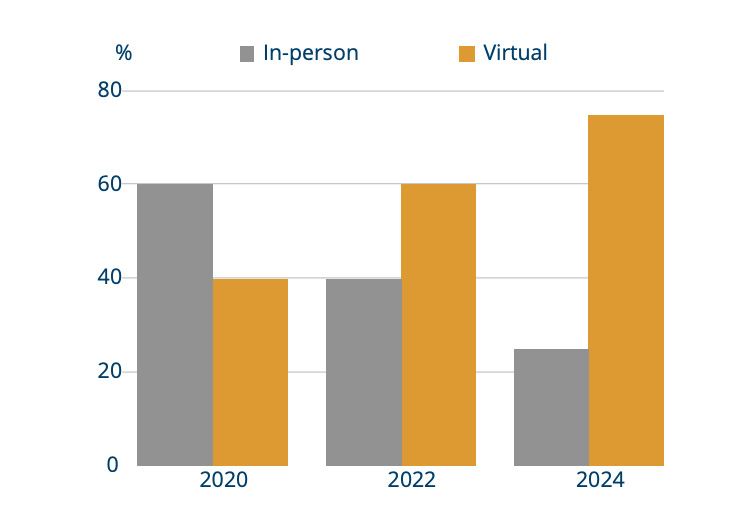
Core Elements to Look for in a Video Solution
Amid all the massive growth that UCC is undergoing overall, one particularly explosive area is videoconferencing.
As anyone who’s been paying attention to changes in smart working can tell you, video seems poised to dominate the UCC market. Statistics back up that inference, too: according to Gartner, in-person meetings are set to drop to just 25% of all meetings in favor of virtual platforms.

Source: Gartner
Considering how Gartner also points out video in UCC will grow at a compound annual rate of 4.2% through 2022, it’s safe to say most of these virtual meetings will involve more than just voice.
But as massive as that growth looks, maybe we should wonder why that rate isn’t even higher.
Because, for all the benefits video brings — all that sense of heightened connection and real-life presence — there are also significant drawbacks.
Setting up a videoconference usually takes combing through endless logins and menus, or, in the case of a physical solution, a massive tangle of wires. Plenty of times, users sit waiting for an update to install before the meeting can begin. The whole ordeal may even become so tough that they have to call in IT staff to handle it.
Add to that unintuitive interfaces, complex routines to invite in external users and a lack of real-time collaboration features (not to mention security issues), and it’s a wonder how videoconferencing is growing at all.
The question then becomes, what would an exceptional, results- and usage-oriented videoconferencing solution look like?
The answer, as we see it, comes down to several key design principles and technologies within one positively spellbinding design philosophy.
Let’s go through them now.
Three Core Principles
From a usability standpoint, an ideal videoconferencing tool should prominently feature three core capabilities: simplicity, security and connectivity.
Here’s exactly what we mean by those points, and how they’d be implemented practically.
1. Simplicity
As repeatedly said in this post, core to any web conference system’s design should be simplified implementation — that is, a smart, straightforward interface that facilitates ease of use.
Rather than lock users behind endless logins or confusing menus, a simple (and therefore preferable) solution would let conferences begin with just the push of a button, a single click on the UI or just opening a web link. The layout must be conducive to usability, with an understandable interface that’s accessible even to users who’ve had little to no training.
2. Security
It almost goes without saying, but IT solutions lose an enormous amount of value in the event that they’re hacked, hijacked or disrupted.
As a result, a usable videoconferencing solution should keep security at top of mind. In fact, security should be so important that it’s an integral — even inseparable — part of the platform. Rather than implement external VPNs or SBCs, in an ideal connection voice and video connections automatically go directly from browser to browser, with no rerouting or mediatory servers.
This would ensure that every conference happens securely, without giving eavesdroppers any chance to listen in and without requiring lengthy setup processes.
3. Connectivity
Another issue constantly tripping up videoconferences is a lack of universal access. From a design perspective, making external users create an account or download software only serves to impede communications.
Solving the issue should therefore entail implementing greater connectivity, both within organizations and outside them. On top of making it simple to create and join conferences between team members, users should also be able to invite external guests in on a session quickly and easily — ideally through an invite link that brings them to a conference page running directly in their current browser.
With no additional downloads or signins, the process would be consistently streamlined and earn higher marks from users.
The Magic of WebRTC and Chrome OS
To get into the practical implementation of these principles, the top candidate for powering such a solution would be Wildix’s first choice for other products: WebRTC.
An in-browser interface that establishes direct user-to-user connections, WebRTC is both dependably secure and highly flexible in deployment. Through this technology, all a system would need to run the tool is a compatible web browser, a webcam and a mic.
For a standalone computing option, such as a webconference station, the dependability of WebRTC should also be augmented by the lightweight, purpose-built power of Chrome OS.
In essence, Chrome OS is just a version of the Google Chrome browser that can power an entire computing environment. Although this limits the system to doing only what a web browser can, that specific usage is ideal for a dedicated web conferencing system; the singular function of Chrome OS would ensure a station setup only provides an excellent videoconferencing experience, without any background processes draining the CPU.
Not to mention, Chrome OS updates itself automatically, ensuring the system has the latest updates well before you start your conference (instead of only updating two minutes before it’s set to begin).
The Payoff
All these elements would come together to create something truly magical: fully realized, real-life sense of presence between disparate offices right at your fingertips.
This simplified approach to enterprise-grade communications means that videoconferencing can finally be something actively chosen for an office setup, not just technology that’s begrudgingly implemented to accommodate vast distances. It means that videoconferencing can become a central conduit connecting the central office to international branches, to smart workers and even to clients who want to meet all of the team at once.
As magical as this combination seems, at Wildix, we put it into a real solution: Wizyconf.
If you want to see what an essential business solution for videoconferencing looks like, click here!